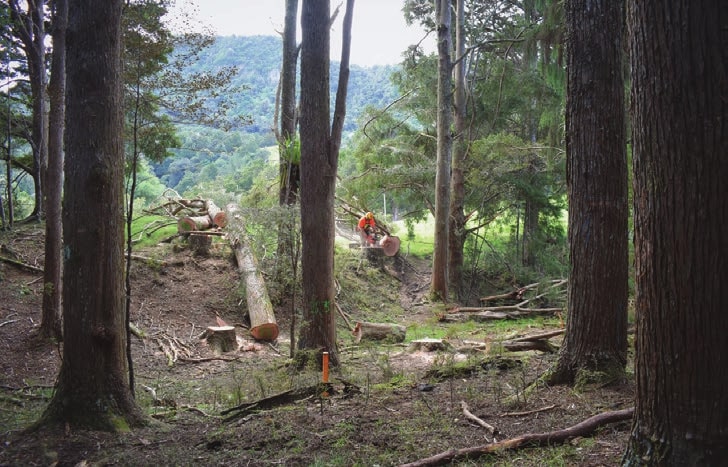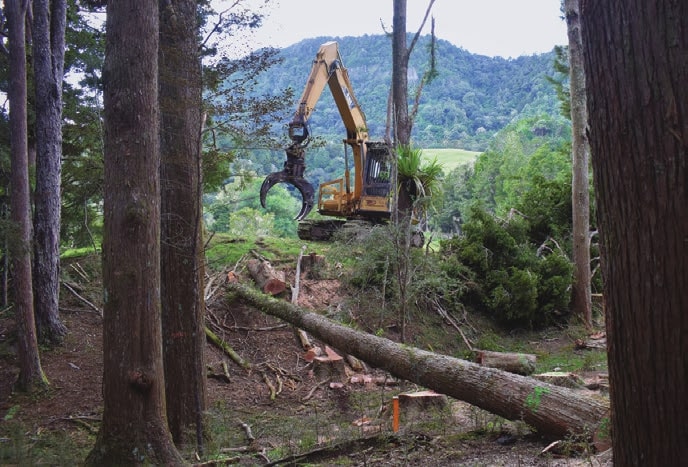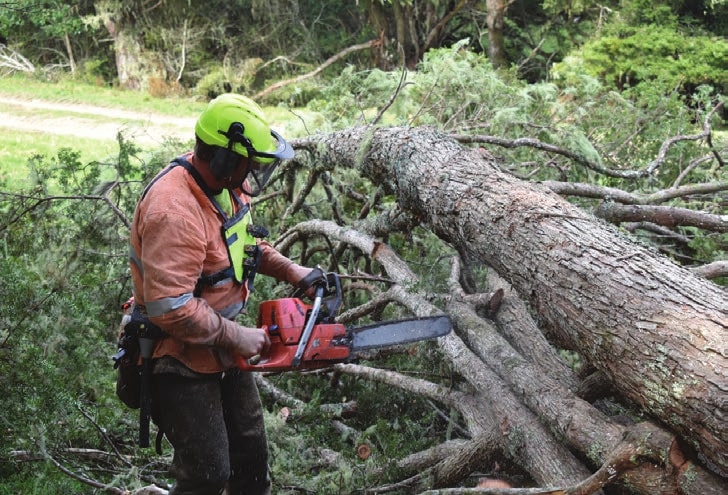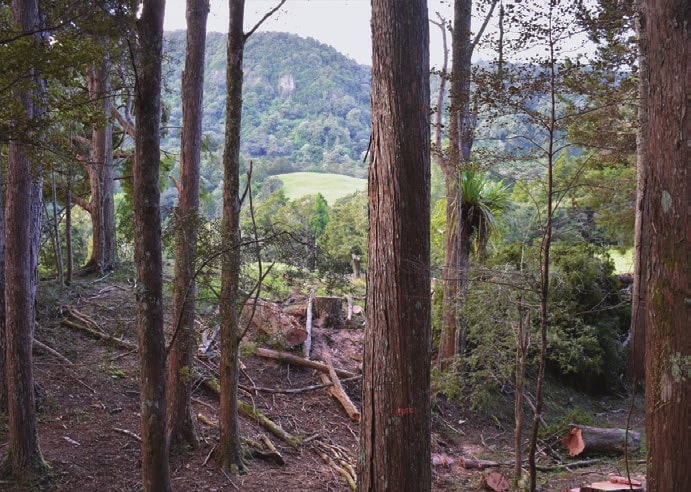Totara industry pilot project: A fresh look at a familiar Northland species
Greg Steward and Paul Quinlan, New Zealand Tree Grower November 2019.
A mosaic of totara Podocarpus totara and grazed pasture is a feature of the Northland landscape. There has been an increased awareness of these stands in recent years as well as an interest in the role they can have in achieving economic, environmental, social and cultural benefits.
An industry producing high-value wood products from sustainably managed totara has the potential to contribute substantially to the Northland economy and the well-being of its people.
The Totara Industry Pilot project is a collaboration between Scion, Te Uru Rakau, Northland Inc., Tane’s Tree Trust and Te Taitokerau Maori Forestry Collective. The project, initiated in 2017, aims to test and develop a business case for a new Northland regional industry based on the sustainable use and supply of totara.
The first round of harvesting and processing has been completed, with a further harvest undertaken in the summer of 2018/19. At the completion of the project a better understanding of the resource, its properties and values will have been obtained and, if the numbers are sound, a business model developed.
The totara resource
Estimates suggest that there are around 200,000 hectares of native scrub and forest cover on freehold land throughout Northland. Totara is the predominant canopy tree species regenerating throughout much of this area. Small densely-stocked stands and isolated trees are common in the rural landscape. Well-established stands are currently used for a range of purposes which include stock shelter and firewood supply.
Totara generally regenerate on sites with poorer pasture growth and where a cover of manuka, or manuka and gorse has established. Many of these young developing stands are clear-felled and re-established in pasture. The stands are often unfenced and are arguably sites where grazing could or should be excluded from without affecting farm activities or income.
A wide variability in stem form and quality is a feature of this farm totara. The range spans trees with significant recoverable clearwood, to poor form trees which are considered to be non-merchantable. This variability in form has implications for harvesting with regard to recoverable log volumes and grades, and also for the long-term management of forested areas. Potentially a high proportion of trees available for harvesting will be subject to edge-effect, with many trees showing features such as heavy branching, multiple leaders, lean and other characteristics that would usually be considered to be defects in saw logs.
The Forests Act
Harvesting totara from natural stands is managed under the provisions of the Forests Act 1949 through Sustainable Forest Management plans and permits administered by Te Uru Rakau. They require continuous cover forestry principles to be applied by specifying the removal of single trees or small groups of three to five trees. Sustainability is defined as maintaining the ability of the forest to provide a full range of products and amenities in perpetuity while retaining the forest’s natural values. A Sustainable Forest Management plan is also required with measures to −
- Protect the forest and in particular, to protect the regenerating forest from pest, stock, fire, and other threats
- Retain and enhance flora and fauna and soil and water quality.
These and other stipulations, such as targeting trees predisposed to early death and wind-throw, reflect that the Act’s provisions were mainly intended for application to old-growth forests rather than young and dynamic second-growth forests which have arisen in highly modified landscapes. Maintaining the existing structure and characteristics of these stands may not necessarily be the most appropriate long-term objective. In many instances, it appears that the productive and environmental values of farm totara stands could be significantly enhanced. Carefully harvesting totara during this project is an opportunity to apply and test management objectives and practices.




Harvesting
A total of 100 cubic metres of standing volume of totara was marked for harvest from one Northland farm site in May 2018. Individual tree selection considered complex inter-relationships, some of which were in conflict.
Value judgements and relative weighting of competing considerations were undertaken based on significant previous experience gained in other private harvests. The selection process considered −
- Health and safety risks along with physical, environmental or property damage
- Minimising or avoiding damage to totara and other non-target native species
- Retaining or improving sustainable production potential from the forest
- Promoting new opportunities for regeneration
- Maintaining stand margins in respect of adverse effects of wind
- Efficiency and economy of operations.
Final tree selection resulted in a harvest where trees were scattered throughout the property. The less accessible steeper areas associated with more diverse native forest cover and waterways were avoided. Areas where trees could be safely extracted, while minimising damage, tended to be on the fringes of grazed pastures
Trees with the best merchantable form based on estimated clear-wood recovery were frequently retained to allow further development. Usually this meant that shorter-bole, larger diameter multi-stemmed trees were removed. Where individual totara were removed from within well-stocked or over-stocked stands, it is assumed that small diameter pole trees will start to grow, and in the future might produce better quality saw log stems.
The pre-harvest inventory included the usual measurements from which standing volumes were estimated. Comments on tree form, branching and obvious log defects were also noted and a form-class rating was assigned. This ranged from one, denoting premium clear wood, to four which was poor form and a large knotty slab grade. Classifying trees into different form classes became a default measure of the sustainability of the harvesting.
One of the first concerns related to the harvest was the availability of suitable Northland-based contractors able to carry out small-scale woodlot or farm forestry harvesting. The contractor engaged specialised in forest woodlot harvesting and used a 22-tonne CAT excavator with grapple attachment. An eight-wheel-drive self-loading John Deere 1410D forwarder was used to recover logs and take them to the loading site. The second major concern was site access difficulties caused by the unusually wet summer and early autumn in Northland in 2018.
A total of 77 trees were eventually harvested, yielding 105 logs, with an estimated total volume of 95 cubic metres. Class three and four trees represented around 65 per cent of the trees harvested and 72 per cent of the estimated merchantable volume. The trees harvested averaged just over 50 centimetres diameter at breast height and six metre merchantable height. Larger trees, up to 87 centimetres diameter at breast height had estimated merchantable volumes of around 3.4 cubic metres. Merchantable height varied considerably but was up to 13 metres.
Most trees were felled outwards into the adjacent paddock. Where this was not possible, the grapple-digger helped with directional felling although it did not enter the stands. It also moved the logs from where they were felled to locations where the forwarder could access them. To enable traceability of sawn timber and finished products to parent trees and stands, tree numbers were sprayed on all logs and also on to their respective stumps during harvest.
| Diameter at breast height in metres | Total height in metres | Merchantable | ||
|---|---|---|---|---|
| height in metres | volume in cubic metres | |||
| Average | 0.501 | 17.7 | 6.1 | 1.243 |
| Minimum | 0.245 | 11.0 | 0.0 | 0.235 |
| Maximum | 0.865 | 26.0 | 13.2 | 3.364 |
| Dimension | Average | Minimum | Maximum |
|---|---|---|---|
| Log length in metres | 5.2 | 2.7 | 7.4 |
| Large end diameter in millimetres | 426 | 240 | 850 |
| Small end diameter in millimetres | 344 | 180 | 840 |
| Volume in cubic metres | 0.647 | 0.140 | 1.888 |
Milling
Logs were transported to the Toi Ohomai training sawmill in Rotorua for processing shortly after felling. A number of log assessments were made before milling including dimensions, final roundwood volumes and heartwood content based on colour at the large and small ends. Stiffness was assessed with the hand-held Hitman Director.
Once assessments were completed, waterproof sheets with barcodes were glued to each log end to track logs and sawn timber. Heartwood, based on observed colour changes in the log, was seen in almost all trees although in significantly varying amounts. Stiffness averaged 7.3 GPa, which is slightly higher than the value for old growth totara. Ring counts indicated an age range of 45 to 103 years for discs taken at five metres, although ring counts were not definitive for a number of trees. Including an estimated 20 years to reach five metres would see an average stand age being around 85 years.
Sawing the timber
Logs were sawn into six different timber dimensions 75 by 25 mm, 100 by 25 mm, 150 by 25 mm, 150 by 50 mm, 200 by 25 mm and 200 by 50 mm, and graded into one of eight grades based on heartwood and sapwood content and defects such as rot, presence and size of knots. Grades used were, in descending order – heart clears, heart dressing, heart mixed, heart box, sap clears, sap dressing, sap mixed and sap box.
Sawn timber volume recovery from the volume entering the mill to the nominal dressed graded volume was just over 50 per cent. The conversion from logs originating from poorer form class three and four trees was in line with that recovered from those with better form class one and two. Almost 7,000 linear metres of sawn timber were recovered, with the majority being from sapwood dressing grades.
The percentage of dressed timber classified as predominantly sapwood tended to be higher in small diameter trees and conversely more heartwood tended to be recovered from larger diameter trees. Heart clears and dressing grades comprised around 18 per cent of the recovered linear metres and almost a quarter of the dressed volume. Heartwood and sapwood clears and dressing grades comprised over 60 per cent of the recovered volume.
The timber was filleted and stacked for air-drying at Scion, with some volume diverted to the development of kiln drying schedules. Successful kiln drying schedules would be a major positive effect on the potential business case. To date, the different timber grades and dimensions have generally remained stable in unrestrained packets.
The ability to definitively identify heartwood has been a problem with segregating timber into the various grades. At present the colour changes seen within a log are used to denote various classes. However, it does not allow for the intermediate wood zone which may exist between sap and heartwood, nor does it account for the relatively young age of the trees harvested. Preliminary investigations have been started to determine whether a chemical signature exists which can be linked to durability properties and colour changes.
The future looks bright
This harvest and milling of totara has provided useful information on the processes, costs and volumes recovered. The findings will be used to for the next harvest which will be undertaken on at least three different farm sites. The results from this, and a smaller pilot Scion funded harvest in 2017, will be used to develop the business case and model. Main observations include −
- Harvesting avoided taking the ‘cream’ of the stands by applying long-term continuous-cover forest management principles with only a small resultant effect on volume recoveries
- Tree selection that included totara with poor form and apparently knotty butt logs, or small diameter top logs resulted in satisfactory volume conversion rates
- Harvesting removed less than 0.1 per cent of all totara on this property
- Grazing is likely to be more damaging to these stands than the careful removal of individual trees
- Coarse woody debris remaining after harvest offers further potential opportunities, or if left in-situ and appropriately managed will contribute to improved environmental results
- Harvesting totara is likely to be limited to summer or dry soil conditions on most sites
- Felling and log-making skills from commercial pine harvests are directly transferable
- Logging equipment used was too large given the dispersed nature of the resource and the on-farm infrastructure which included narrow access points, tight turns, gates, and non-engineered farm tracks, bridges and stream crossings
- Low-impact harvesting totara from farmland using sustainable forest management criteria appears to be practicable.
The start of an industry
Results from the first harvest has found that volume recoveries at all stages were generally higher than expected, as was the recovery from poorer form trees. Combining this data with data from future harvests could help and support the development of a business case for totara representative of a broad range of ages, sites and tree qualities in the Northland region. Moreover, it appears that the productive and environmental values, such as erosion control, biodiversity and conservation of farm totara stands could be maintained or even significantly enhanced.
This has been more than just a research project. It is expected that it will contribute to the start of a successful regional industry. It would be an industry which is about more than just commodities and profit – one which also has strong environmental, cultural and social values. To recognise this the project’s steering group has adopted the guiding notion He totaratuturu – He iwi tu tonu Sturdy totara – sustainable communities.
Greg Steward leads the indigenous forestry programme at Scion and is the technical lead for the forest component of the TIP project. Paul Quinlan is a qualified landscape architect and trustee of Tane’s Tree Trust.

 Farm Forestry New Zealand
Farm Forestry New Zealand